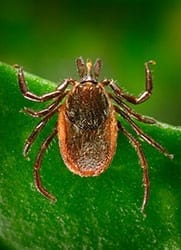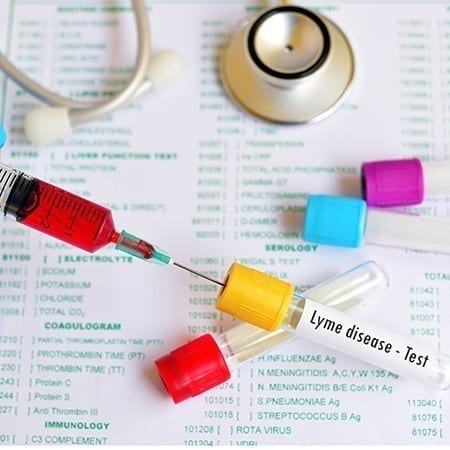
Credit: James Gathany/CDC
When it comes to early diagnosis of Lyme disease, the insidious tick-borne illness that afflicts about 300,000 Americans annually, finding the proverbial needle in the haystack might be a far easier challenge—until now, perhaps. An experimental method developed by federal and university researchers appears capable of detecting the stealthy culprit Lyme bacteria at the earliest time of infection, when currently available tests are often still negative.
The team suggests the approach might also be useful for early detection of other elusive bacterial infections. The collaborators—from the National Institute of Standards and Technology (NIST), Institute for Bioscience and Biotechnology Research, and Johns Hopkins School of Medicine—recently reported the successful first trial of their new method.
“Our hypothesis was that Lyme bacteria shed vesicle-like particles—or fragments—derived from the cell wall of the bacteria circulating in the serum of individuals. These particles would contain membrane proteins that can be detected to provide a unique indicator of infection,” explains NIST research chemist Larik Turko.
The challenge was to detect these bacterial membrane proteins among the far, far more plentiful proteins normally present in serum, the watery, cell-free component of blood. The researchers speculated that running serum samples through a high-speed centrifuge—a standard step in chemistry labs—might selectively concentrate the larger, heavier fragments containing the bacterial membrane proteins into pellets. In effect, they predicted, this step would separate the wheat—the sparse target proteins—from the chaff—the much more abundant human serum proteins.
The new method’s promise was demonstrated in tests on serum samples drawn from three patients with undetected Lyme disease at the time of their initial doctor visit. By customizing standard analytical techniques for determining the types and amounts of chemicals in a sample, the team detected extremely small amounts of the target protein in all three samples.
For chemistry buffs, the protein in enriched samples was present at a level of about four billionths of a millionth of a mole, the standard unit for amount of substance.
In one patient, the experimental method detected the bacteria three weeks before infection was confirmed with the standard blood tests now used. For the other two, infection was detected simultaneously by the two methods.
“The complexity of Lyme disease, combined with lack of biomarkers to measure infection, has slowed progress,” study collaborator John Aucott, head of the Johns Hopkins Lyme Disease Clinical Research Center, said in advance of a session on precision and personalized medicine this weekend at the AAAS 2016 Annual Meeting in Washington, D.C. “Now, thanks to recent advances in technology, the tiniest concentration of blood molecules can now be detected, molecules that were previously ‘invisible’ to scientists.”
The current standard blood test for Lyme disease exposes the infection only after antibodies have accumulated to detectable levels, which can take up to 4 to 6 weeks. If patients exhibit a telltale bull’s-eye rash, diagnosis and treatment can begin earlier. But the rash does not occur in 20 to 30 percent of Lyme disease patients, according to the Centers for Disease Control and Prevention.
Rather than waiting for an infected person’s immune system to produce noticeable amounts of antibodies, the team chose to home in on the bacteria itself—specifically, proteins the bug sheds when attacked by the body’s defenses.
“From many candidates, we chose one that is both easily distinguished from human serum proteins and an unambiguous indicator of the bacteria,” Turko says. “This protein, which resides on the outer surface of membranes, became the target of our search in serum samples.”
But finding that target required an important preliminary step to ensure the accuracy of their measurements: making a reference sample that contained ample amounts of the target protein. With the reference sample, the team established the unmistakable signature the bug’s outer-surface membrane protein would yield when they examined samples drawn from patients. As a result of these steps, the team could detect the copies of the target protein, even though human proteins were 10 million times more plentiful.
“We believe that this approach may be universally applicable to detection of other bacterial infections in humans,” the researchers write.
Learn more: New Experimental Test Detects Signs of Lyme Disease Near Time of Infection
The Latest on: Lyme disease
[google_news title=”” keyword=”Lyme disease” num_posts=”10″ blurb_length=”0″ show_thumb=”left”]
via Google News
The Latest on: Lyme disease
- Was Lyme disease spread as a bioweapon? No, that theory is Pants on Fire!on May 16, 2024 at 3:07 pm
Further, Diuk-Wasser said, Lyme disease would be a "terrible bioweapon" because the bacteria and ticks grow very slowly, need specific habitats to survive and are transferred through tick bites, which have a slower transmission rate than diseases spread through other means, such as respiratory viruses.
- Long Dismissed, Chronic Lyme Disease Is Finally Getting Its Momenton May 16, 2024 at 11:38 am
Over the next two decades, Gray’s neurological issues continued and she progressively developed new symptoms: numbness and tingling in her back, chronic pain, anxiety, and an uncontrollable rage that made her feel like an entirely different person. She knew something was seriously wrong, but she didn't know what. “I was scared to death,” she says.
- Is Lyme disease contagious?on May 15, 2024 at 7:08 pm
Lyme disease is not contagious. It does not spread from person to person. To become infected with the bacteria, a person must have been bitten by a tick that is infected with the bacteria. According to the CDC, in most cases, a tick must be attached for 36 ...
- 3 Early Warning Signs of Lyme Disease You Shouldn’t Ignoreon May 15, 2024 at 12:54 pm
Tick-borne diseases are on the rise in the U.S. And a recent report from the Centers for Disease Control and Prevention (CDC) shows that the most common type, Lyme disease, may be a greater burden than previously estimated.
- Maine CDC marks Lyme Disease Awareness Monthon May 14, 2024 at 4:15 am
The Maine Center for Disease Control and Prevention urges Maine residents and visitors to take precautions to make tick prevention a “big deal” this month. Gov. Janet Mills has again proclaimed May Lyme Disease Awareness Month;
- Bella Hadid returns to work after Lyme disease treatmenton May 14, 2024 at 2:18 am
The 26-year-old model took a step back from her career in order to undergo treatment for Lyme disease - which she was first diagnosed with in 2012 - but she revealed to fans on Wednesday (09.08.23) night she was back on set for a new job. Bella shared a ...
- Local Chiropractor Dr. Kristi Hellenbrand Addresses Lyme Disease Awareness at Peachtree City Libraryon May 14, 2024 at 2:00 am
In recognition of Lyme Disease Awareness Month, Kristi Hellenbrand, DC, will be speaking at Peachtree City Library on Saturday, May 11, 2024, at 1 p.m. in the Storytime Room. Dr.
- Probability of developing Lyme disease is genetically influenced, research suggestson May 13, 2024 at 7:48 am
Lyme disease is the most common disease transmitted by tick bites in Germany. Whether a particular genetic predisposition plays a role in the development of the disease and which immunological processes in the body are involved is not yet sufficiently understood.
via Bing News











